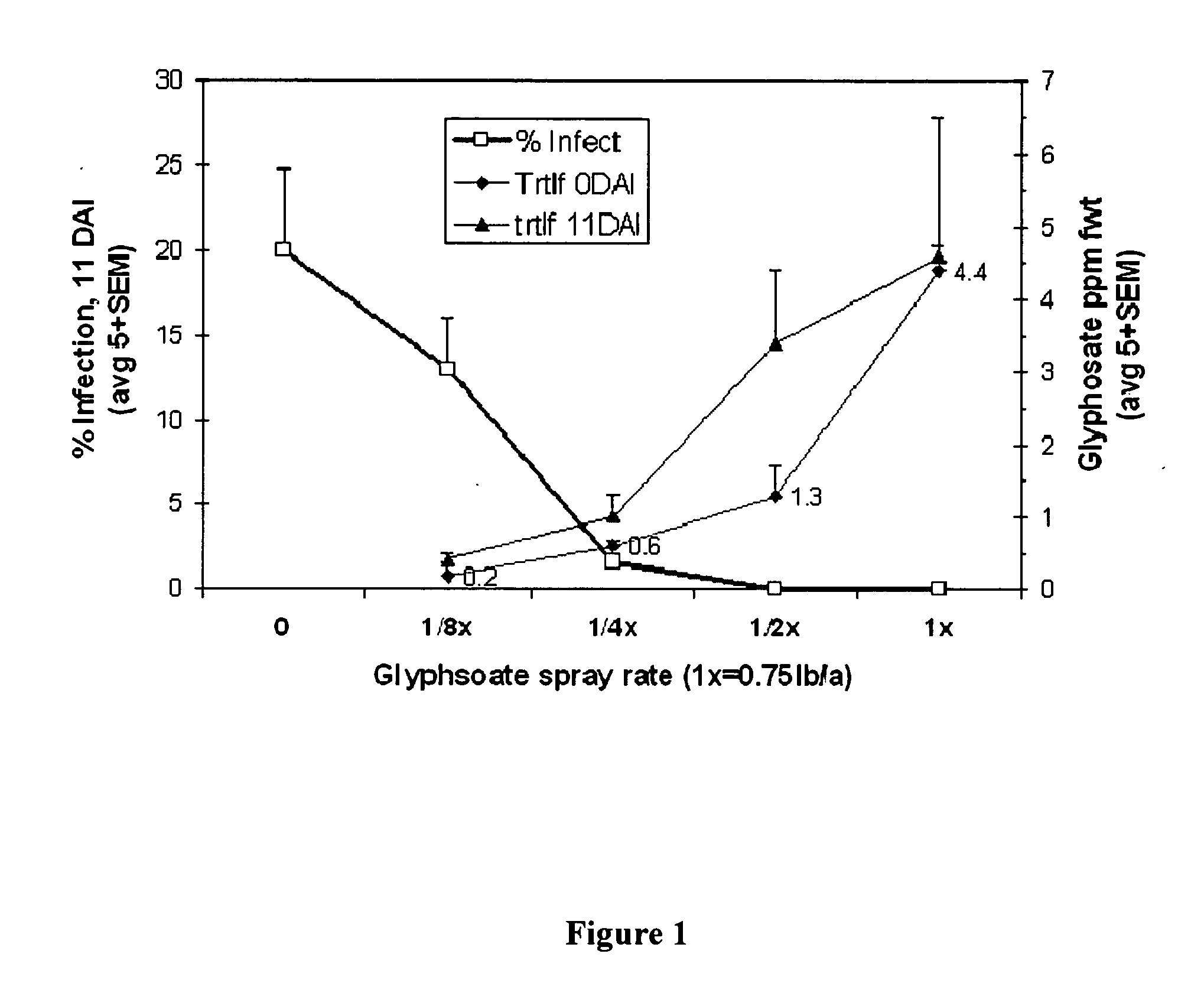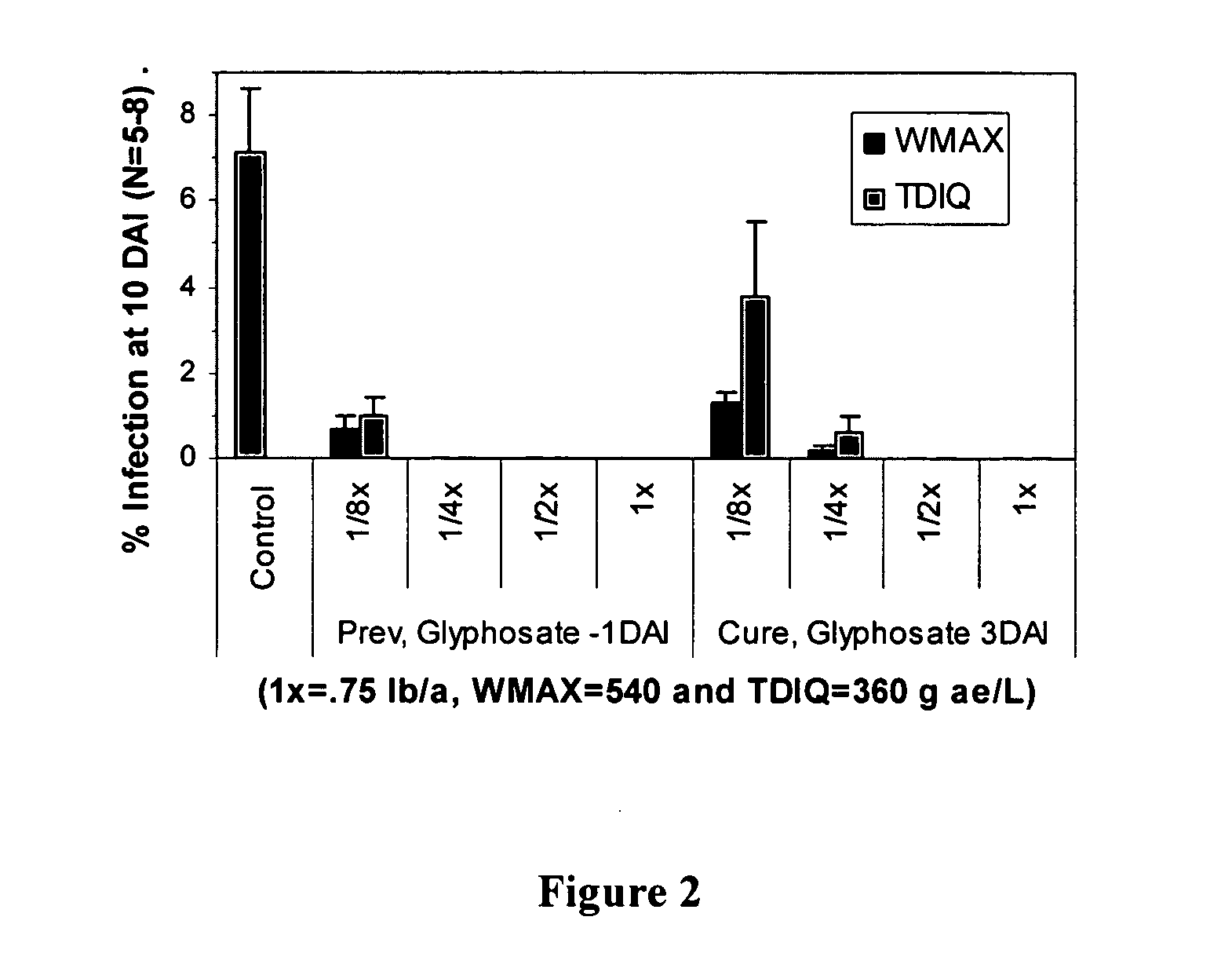Methods for controlling plant pathogens using N-phosphonomethylglycine
a technology of n-phosphonomethylglycine and pest control, which is applied in the field of pest control methods and compositions for plants, can solve the problems of increasing the cost of growing crops and environmental impact, increasing the cost of crop loss control, and increasing so as to prevent or control plant diseases, reduce crop residues and environmental residues, and reduce the number of chemical applications
- Summary
- Abstract
- Description
- Claims
- Application Information
AI Technical Summary
Benefits of technology
Problems solved by technology
Method used
Image
Examples
example 1
In vitro Effects of Glyphosate on Plant Pathogens
[0090] In vitro screens identified glyphosate as a very weak fungicide against a series of pathogenic organisms. Table 2 shows that when various fungal plant pathogens are grown on growth media containing various concentrations of glyphosate to measure EC90 concentrations (the concentration for 90% of maximal effect of, e.g., inhibiting fungal cell proliferation or statistically reducing the level fungal growth). These data demonstrate a high concentration of glyphosate is required to inhibit fugal growth in vitro. It was therefore a surprising result when it was observed that glyphosate tolerant plants when treated with glyphosate showed resistance to fungal disease. The glyphosate residue analysis shown in Table 1 would have suggested that the levels of glyphosate in the plant tissues to be too low for effective inhibition of fungal pathogens. The susceptibility of fungal pathogens to glyphosate effects may change when the pathogen...
example 2
Disease Treatment in Glyphosate Tolerant Wheat
[0091] Compositions of water, surfactant (a 0.1% solution), glyphosate formulations (WeatherMAX® (glyphosate-K salt), UltraMAX® (glyphosate-IPA salt), or a glyphosate composition without surfactant (IPA-salt) are applied to glyphosate tolerant wheat plants at different growth stages that have been previously inoculated with leaf rust (Puccinia triticina) to test for disease control. Three, five and seven-leaf stage wheat plants are inoculated with Puccinia triticina spores and incubated to allow for spore germination.
[0092] Plants are evaluated for disease at one day after treatment (1DAT) with the above compositions. In addition, wheat plants at the 5 leaf stage are used as an untreated control.
[0093] All eleven (11) untreated wheat plants exhibited significant leaf rust symptoms. Seven out of eight water-treated wheat plants (3-leaf stage) showed disease symptoms. Similarly, surfactant-treated plants at the 3 leaf and 7 leaf stages ...
example 3
Correlation of Tissue Glyphosate Concentration and Disease Prevention
[0096] To determine the correlation between glyphosate concentration in plant tissue and disease control, glyphosate tolerant wheat plants are treated with glyphosate compositions prior to inoculation with Puccinia spores. Four different regimens are employed. First, whole plants, either 3-leaf or 5-leaf stage, are treated with a 1× spray of WeatherMAX Roundup® glyphosate composition. A single mature leaf from each treated plant is inoculated with Puccinia spores either 1 day or 14 days after glyphosate application. The inoculated plants are then incubated for 24 hours at 100% relative humidity for germination of the spores. Twelve days after inoculation, disease conditions are evaluated and concentrations of glyphosate in the plant tissue is quantitated. Disease conditions are evaluated macroscopically for pustule development and lesion development.
[0097] Disease symptoms were prevented in inoculations both at 1...
PUM
| Property | Measurement | Unit |
|---|---|---|
| volume | aaaaa | aaaaa |
| time | aaaaa | aaaaa |
| volume | aaaaa | aaaaa |
Abstract
Description
Claims
Application Information
 Login to View More
Login to View More - R&D
- Intellectual Property
- Life Sciences
- Materials
- Tech Scout
- Unparalleled Data Quality
- Higher Quality Content
- 60% Fewer Hallucinations
Browse by: Latest US Patents, China's latest patents, Technical Efficacy Thesaurus, Application Domain, Technology Topic, Popular Technical Reports.
© 2025 PatSnap. All rights reserved.Legal|Privacy policy|Modern Slavery Act Transparency Statement|Sitemap|About US| Contact US: help@patsnap.com


